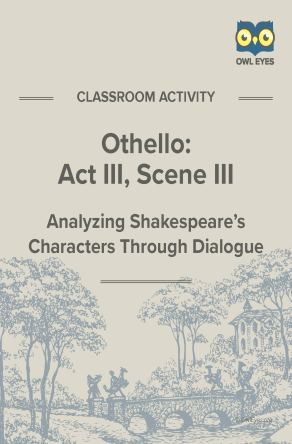Othello Act III, Scene III Dialogue Analysis Activity
- 14 pages
- Subject: Character Analysis, Tone, Lesson Plans and Educational Resources
- Common Core Standards: RL.11-12.1, RL.11-12.5, RL.9-10.1, RL.9-10.3
- Grade Levels: 9, 10, 11, 12
Additional Othello Resources
Product Description
In The Tragedy of Othello, Shakespeare creates a tragic hero who is destroyed by fatal flaws in his own character. Driving Othello’s tragedy is his pride and personal insecurity, qualities that make him vulnerable to jealousy and suspicion. A valiant and respected general in service to the duke of Venice, Othello is led to believe that his wife, Desdemona, has betrayed him by carrying on an adulterous affair with Michael Cassio, one of his lieutenants. Sick with jealousy and rage, Othello eventually smothers Desdemona with a pillow as she begs for her life, and he subsequently kills himself when he learns that she had been innocent. The villain orchestrating the drama is Iago, Othello’s ensign, who seeks revenge for Othello’s promoting Cassio over him. Iago’s secret and malignant intentions are established immediately in act I, and the plot unfolds as he carries them out. In act III, scene III, Iago manipulates Othello to ingratiate himself, condemn Cassio, and destroy Othello’s peace and happiness by convincing him that Desdemona is unfaithful. Also appearing in the scene are Desdemona; Iago’s wife, Emilia; and Cassio.
Skills: character analysis, drawing inferences from text, interpreting diction for connotative meaning
About This Document
The Owl Eyes Dialogue Analysis activity gives students an opportunity to practice examining and analyzing passages from Shakespeare’s plays. Since the theaters of Shakespeare’s time lacked elaborate sets and lighting and his scripts have sparse stage directions, dialogue is one of the few tools we can employ in understanding his characters. This worksheet focuses on the essential role of diction (word choice) in creating mood and subtext in each scene, developing characters, and establishing events in the plot. The main components of this activity include the following:
- A contextualized summary of the selected passages
- A selection of excerpts for examination
- A table with scaffolded question progression
- A step-by-step guide to activity procedure
- A complete answer key
In completing this activity, students will be able to analyze passages of dialogue to identify the speaker’s character traits, conflicts, and motivations as well as determine how diction creates mood.







